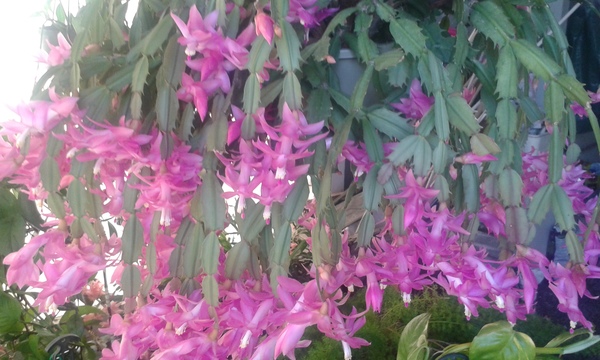As I said when I started this column, I am not an expert gardener and one of the many things I struggle with is the complicated botanical names of plants.
This week I am going to start with the botanical name.
The beautiful plant I am going to describe is called “schlumbergera truncata”.
It is native to a small area of coastal mountains in south eastern Brazil where its growing conditions are sub-tropical or tropical moist rainforest, and yet they grow quite well in hanging baskets in Warwick.
They are cacti but not a desert plant and can be grown quite successfully all over Australia.
They are named for the 19th century cactus collector Frederic Schlumberger who lived near Rouen in France.
They are “epiphytes”, plants that depend on others for support but not nutrition.
Their colour used to be restricted to bright pink but, due to the efforts of plant breeders here and in Japan and America, they now come in a wide range of colours from white right through lavender, corals, yellows, oranges, pinks and purples.
They don’t like direct sunlight, so hanging baskets in a greenhouse or under a shady tree is an ideal situation.
They are easy to propagate from cuttings and for best results break off a segment and leave it lying about until aerial roots begin to develop before planting in good free-draining potting mix.
It can take anything from a few days to several weeks for these aerial roots to develop.
They require little attention and minimum water other than when they are actively growing and flowering.
They like a feed with a good, low nitrogen, all-purpose fertiliser in spring, and will reward with a spectacular show of flowers at this time of year.
As an epiphyte, they require little fertiliser as they usually rely on what they get from above as they grow on a tree branch.
Their flowering is triggered by shorter days and longer nights and they don’t like frost but can tolerate low temperatures.
To force them to flower earlier, try covering them with a cardboard box for 15 hours a day.
As an indoor plant, even artificial light will disrupt the flowering cycle. Once they have started to form buds it is best not to move them as they don’t like to be disturbed.
In the northern hemisphere they are often called the Christmas cactus – or in America the Thanksgiving cactus – as that is the time they flower.
In their native southern hemisphere area they are known as the May flower.
The common name is, of course, the Zygo cactus, much easier to remember than the botanical one!
On Wednesday night 31 May, a very interesting and informative night was hosted by the Horticultural Society.
Heather Prior demonstrated flower arranging through the ages with a traditional arrangement, an arrangement from the ’70s, a European style and a modern artistic arrangement using a minimal amount of flowers.
As she assembled the arrangements Heather explained the intricacies of each style and what a judge would be looking for.
Noel Prior then explained some of the tricks in effectively displaying flowers for judging.
It is most important to have a flower standing well in the jar as “if the flower isn’t looking at the judge, the judge won’t be looking at the flower!”
Noel also explained and demonstrated how to prepare a pot plant for the judge.
The most important points for this were to have the pot well cleaned, a neutral colour and to have the plant centred in the pot.
In the months leading up to a show, it is important to turn the pot every few weeks to keep the plant growing symmetrically.
The pot should not be the centre of attraction even if the colour complements the flowers on the plant.
That may be lovely at home but not for judging!
Plants for exhibition should ideally be in a black or dark green pot so as not to detract from the plant. The plant is, after all, what is being exhibited.
We were fortunate to have the Priors come and speak to us and I am sure that those who took advantage of the information night learnt a lot that will be put into practice for the Spring Flower Show in October.
Don’t forget the bus trip to Nambour to the Qld Garden Expo on 8 July. Tickets are available as usual at Danny Lyons Sports in Palmerin Street.







